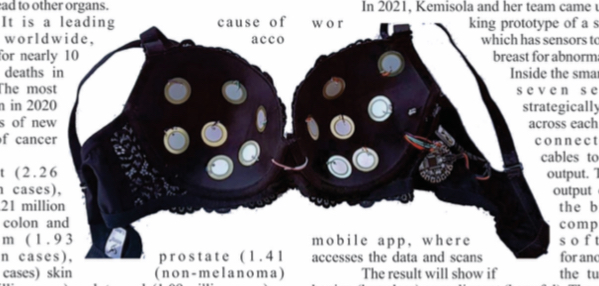When the news that a smart Bra has been invented by a Nigerian for early breast cancer detection was broken, it was an answered prayer to so many people and the more this invention information keeps spreading the better.
Cancer is a generic term for a large group of diseases that can affect any part of the body. One defining feature of cancer is the rapid creation of abnormal cells that grow beyond their usual boundaries, and which can then invade adjoining parts of the body and spread to other organs.
It is a leading cause of death worldwide, accounting for nearly 10 million deaths in 2020. The most common in 2020 in terms of new cases of cancer were:
Breast (2.26 million cases), lung (2.21 million cases), colon and rectum (1.93 million cases), prostate (1.41 million cases) skin (non-melanoma) (1.20 million cases); and stomach (1.09 million cases).
Each year, approximately 400 000 children develop cancer and the most common cancers vary between countries. Cervical cancer is the most common in 23 countries.
According to the World Health Organization (WHO), 2.3 million women were diagnosed with breast cancer in 2020 alone globally. Of those, 685 000 died. The report further stated that by the end of 2020, there were 7.8 million women alive who had been diagnosed with breast cancer in the past five years, making it the world’s most prevalent cancer.
The high mortality rate recorded in breast cancer in the region is largely attributed to late diagnosis which led to the invention of the “Smart Bra” by Bolarinwa Kemisola.
Bolarinwa Kemisola is a Nigerian robotic engineer who was motivated to develop a “smart bra” to aid the early detection of cancerous tumours. Bolarinwa’s interest in Cancer prevention and treatment was borne out from an emotional event.
In 2017, she lost one of her favourite aunts to breast cancer. She described how painful seeing several women lying in pain was while visiting her aunt at the University of Ibadan Teaching Hospital and on that day, she committed herself to finding a solution to breast cancer.
Watching the women broke her heart, especially the young girls; the pain, helplessness, and resignation were too much and during her conversation with the doctor, she learned that 9 out of 10 women survive breast cancer with early detection. And at that point, she realized her next challenge which is invention of something to aid early detection of cancer since checking the breast regularly and early detection is the solution.
In 2019, Bolarinwa teamed up with a femwear expert, an IT expert, an embedding hardware expert, an AI expert, a software developer, and an oncologist. Together, they embarked on a journey to find a solution to the late detection of breast cancer.
In 2021, Kemisola and her team came up with a working prototype of a smart bra which has sensors to scan the breast for abnormalities.
Inside the smart bra are seven sensors strategically placed across each bra cup, connected via cables to a USB output. The USB output connects the bra to a computer or mobile app, where software accesses the data and scans for anomalies.
The result will show if the tumour is benign (harmless) or malignant (harmful). The smart bra must be worn on the breasts for a maximum of 30 minutes for the result to show. The app also has an interface for the result to be transmitted to a doctor.
The smart bra invented was confirmed to be safe and easy to use after she was able to do a test run on a prototype of the smart bra in 2021.
The smart bra was nanotechnology with tiny ultrasound sensors that can scan the breasts and reveal the location of any tumour; hence it does not have any side effects. This bra however doesn’t replace normal bra or is worn throughout the day. This particular bra is worn during the breast cancer check which doesn’t last more than five minutes.
Bolarinwa said the smart bra innovation is far more than about a tech innovation or a war on cancer but “It is all about finding solutions to problems and inspiring the female gender to break the bias that curtails women’s potential.
